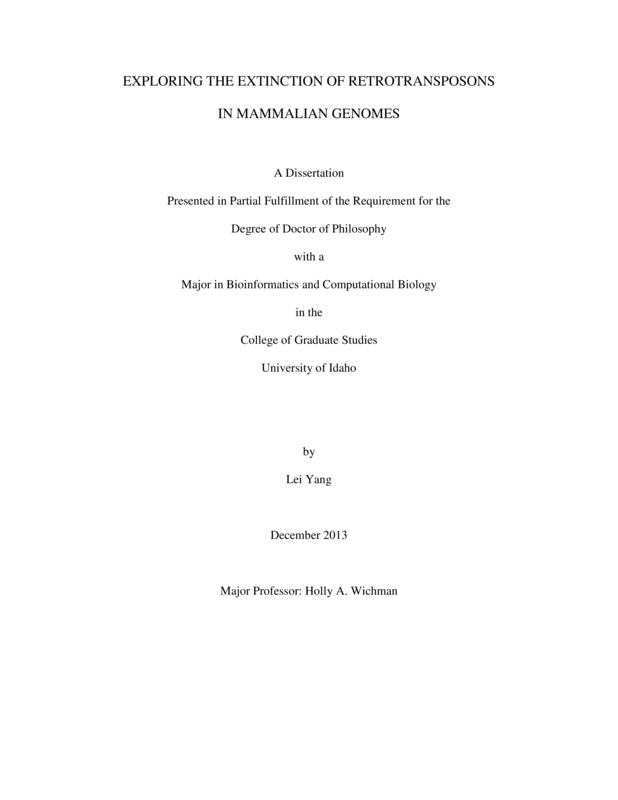Exploring the Extinction of Retrotransposons in Mammalian Genomes
Yang, Lei. (2014). Exploring the Extinction of Retrotransposons in Mammalian Genomes. Theses and Dissertations Collection, University of Idaho Library Digital Collections. https://www.lib.uidaho.edu/digital/etd/items/yang_idaho_0089d_10066.html
- Title:
- Exploring the Extinction of Retrotransposons in Mammalian Genomes
- Author:
- Yang, Lei
- Date:
- 2014
- Keywords:
- B1 extinction L1 oryzomys pteropus sigmodon
- Program:
- Bioinformatics & Computational Biology
- Subject Category:
- Bioinformatics; Biology
- Abstract:
-
LINEs and SINEs are mobile genetic elements in mammalian genomes which move by retrotransposition, although SINEs are dependent on LINEs. Together LINEs and SINEs comprise approximately a quarter of a typical mammalian genome. However, the major family of LINEs, L1, was found to have become inactive in the whole megabat family ~24 MYA and in a large group of South American rodents ~8 MYA. Besides, in these rodents, a family of SINEs, B1, lost its activity prior to that of L1 despite its dependency on L1s. Examination of the evolutionary history of L1 in these L1-extinct groups revealed a surprising diversity. Megabat L1s are unique in that two parallel and fairly synchronized L1 lineages persisted in the genome and both underwent extinction soon after a significant wave of L1 deposition occurred. Reconstructions of the most recent common ancestor of the extinct megabat L1 were tested in tissue culture assays and actively retrotransposed. The evolutionary history and reconstruction of the megabat L1 suggests that L1 extinction is unlikely the consequence of degenerative L1 sequence or long-term L1 quiescence. The L1 and B1 evolutionary histories in the South American rodents show that L1s maintained activity until after the split of the basal group carrying active L1s but inactive B1s. B1 retrotransposition tempo is comparable in the L1-extinct clade and the basal group; the most recent wave of B1 retrotransposition is prior to the separation of the basal group and this wave is the largest one detected. Thus, in both the megabat and rodent cases there was a large wave of retrotransposition prior to L1 extinction, suggesting that completion between elements, or between elements and the host, may have contributed to L1 extinction. The study of mammalian genome evolution in non-model organisms has become increasingly viable in the current genomic era and will continue to broaden our understanding of the complex regulatory mechanisms of life.
- Description:
- doctoral, Ph.D., Bioinformatics & Computational Biology -- University of Idaho - College of Graduate Studies, 2014
- Major Professor:
- Wichman, Holly A
- Committee:
- An, Wenfeng; Brown, Celeste J; Foster, James A
- Defense Date:
- 2014
- Identifier:
- Yang_idaho_0089D_10066
- Type:
- Text
- Format Original:
- Format:
- application/pdf
- Rights:
- In Copyright - Educational Use Permitted. For more information, please contact University of Idaho Library Special Collections and Archives Department at libspec@uidaho.edu.
- Standardized Rights:
- http://rightsstatements.org/vocab/InC-EDU/1.0/

